Ancient Ships: The Ships of Antiquity
Ancient Ships in art history: Egyptian Ships in ancient Egypt
and Egyptian art Hapshetsut's Expedition to Punt
The record of ancient seafaring and trade as recorded in Egyptian
art at Queen Hatshepsut's temple at Deir el-Bahri Circa 1480 BCE
 
Queen Hatshepsut's temple
Hatshepsut is well known for her ambitious building
projects in Egypt particularly the erection of several Obelisks’
at Karnack and her funerary Temple at Deir el-Bahri. In her time
Hatshepsut was a model of feminine mystic, power and political acumen.
Her accomplishments in ancient Egypt rank well when compared
with , Queen Ferdinand of Spain, Queen Elizabeth 1 of England
and Catherine the Great of Russia.
After examining the contribution she made to the
new Kingdom, historians generally agree this person was one of the
greatest contributors to Egypt's ancient legacy in world history.
Hatshepsut's character and personal history is another
story, this page is dedicated to her expedition to Punt. This
expedition is an indicator of her leadership and skill in motivating
and governing the Egyptian society of her time to high achievement.
The story of Hatshepsut's expedition to punt is recorded for posterity
in the Egyptian art on the wall of her memorial temple.
The time slot for this adventure was 1480 BCE.
Egypt was in the New Kingdom, had stable boarders, was recognized
as the breadbasket of the Mediterranean. Egypt had recently successfully
colonized Nubia and had a seemingly endless supply of gold
coming into its treasuries from their southern allies.
Egypt had 2000 years of high civilization under its belt, what could
a girl do that was noteworthy.
Egypt was capable of asserting its military power
against any enemy if the situation required. This fact would be
demonstrated by the Military exploits of Tutmohsis III who
was Hatshepsut's co-ruler and predecessor.
From her own account of things as recorder
in her temple it appears Hapshetsut consulted her Gods and was
told to follow in the footsteps of her ancestors and re-establish
old trading associations that had fallen into the hands of middle
men.
Apparently for years the Pharaohs had been dealing
with middle men to acquire trade commodities coming to them from
the east and south through the Red Sea and eastern desert trade
routes Between Luxor and the Red Sea.
Hatshepsut's inspiration, recommendation
and solution to this problem was to mount an expedition that would
cut out the Middle man and go directly to the source of supply
for many of these commodities. This plan required the organization
of a fleet of seaworthy sailing ships and a military unit to make
the expedition.
Hapshepsut's task force was organized, launched
and proceeded to meet their goals in bringing the trade goods
of Punt to Egypt without the need for trade through middle men.
This page is dedicated to showing the ships used to make the journey
and to discussing the implications of the use of Egyptian seafaring
technologies at this time in History.
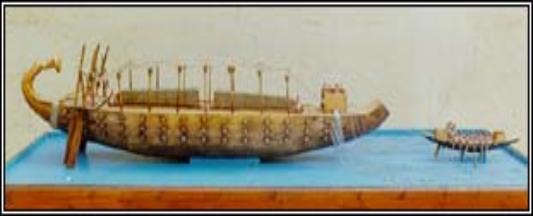
Obelisk Barge
Above is a model of a river barge used for
transporting obelisks from quarries to the installation sites. These
freight barges were the Egyptians primary use of displacement craft
with wooden hulls. The ship building experience gained from building
these types of freighters for the transportation of large scale
building materials could have easily been transposed to the technologies
applied in the building of sea-going vessels.
Displacement craft of this type would have
been used in the construction of the Pyramids. The need to transport
large stones of up to 70 tons from remote quarries to the site of
the pyramids would have required the Egyptians to have developed
this technology when building the Pyramids. This means the technology
and its application for building this type of ship was approximately
1000 years old by the time Hatshepsut built her fleet.
Another indicator for this conclusion was the fact
that Sahure had built seafaring craft and sailed the high seas in
2450 BCE and had recorded his exploits at his Pyramid complex.
Sahure may have been one of the ancestors Hatshepsut had made reference
to in her temple. It is clear that seafaring had been a regular
undertaking in Egyptian history but needed a current champion
to undertake a noteworthy expedition during this generation of Egyptians.
Hatshepsut in her wisdom decided to champion
the cause and record it for history.
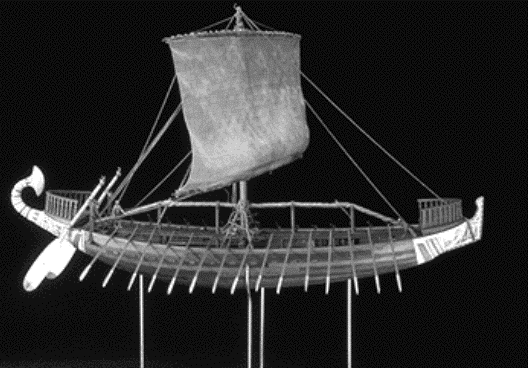
A modern model of an Egyptian Seagoing Vessel
XVIII Dynasty (1580-1350 B.C.)
August F. Crabtree Collection of Miniature Ships
Mariners' Museum, Newport
News, Virginia
The ship illustrated above is the kind of vessel the ancient
Egyptians would have used to in their trading expeditions to Punt
and the African sub -continent. Below is a low relief placed in
the wall of Queen Hatshepsut's temple at Deir el-Bahri. The walls
of the temple are covered with reliefs and hieroglyphic records
of the events and highlights of this trading expedition to the land
of Punt, Circa 1480 BCE. These relief panels record a key event
in Egyptian history.
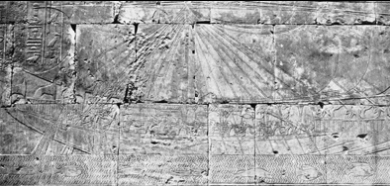
Relief showing ships which participated in the expedition to Punt.
This mural and others adorn the walls of Queen Hatshepsut's temple
at Deir el-Bahri.

The petroglyphs of the Egyptian Eastern Desert provide the
earliest record of the use of ships in the Egyptian culture.
Some of these are dated to the Naquada I period but many of these
are yet to be dated. Current research is trying to determine the
dating and relevance the petroglyphs have to later developments
in the use of ships in the Egyptian culture. Fortunately for
the researcher Egyptian Art is replete with images of ships form
the Naquada period to the Roman conquests.
Egyptian art gives us evidence for the use of wooden
boats from at least as early as the beginning of the fourth millennium
BCE on scraps of papyrus which show part of a sickle shaped hull
in which the paddlers appear to be sitting inside the boat rather
than on of it, as would be the case if the boat was a reed raft.
Wall panels a Sahure's funerary temple show evidence for the types
of ships used at the time the Pyramids were built.
By 2700 BC Egyptian civilization had developed economically
and politically to the point that it was creating a powerful impression
that found its expression in grandiose architecture. The transportation
of building materials from quarries further up the Nile stimulated
the development of substantial wooden vessels capable of transporting
and supplying these new needs. In addition the temples and palaces
were themselves part of an elaborate funerary cult in which special
boats were used to transport the corpse to the Necropolis on the
other side of the Nile, and, symbolically, to assist the spirit
in its passage into the afterlife. The view of death as a passage
across water is common to many cultures and in itself testifies
to the importance of boats in those cultures.

Middle Colonnade Relief, South Side
Relief Depicting the Expedition to the Land of Punt
Drawings made as copies of the Egyptian Art reliefs recording
Queen Hatshepsut's expedition to the Land of Punt. One the first
oceanographic expeditions recorded in art history.
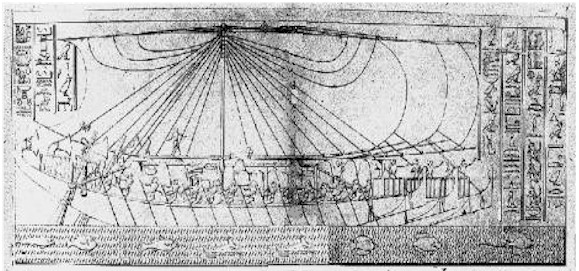
Line drawing copy from a relief of Queen Hatshepsut's
expedition to the Land of Punt.
The Egyptian Sea going ships were apparently built in much the
same way as river craft designed for transporting heavy construction
material such as huge stones and obelisks. The earliest evidence
for this comes from iconography of around 2450BC, which shows long
slender hulls with considerable overhang, essentially enlarged versions
of the river craft. The inherent longitudinal weakness of the reed
raft inspired hulls was compensated, even at this stage, by the
addition of hogging trusses running above the decks, and also by
a substantial webbed girdling truss running round the hull just
below the sheer strake which provided some lateral reinforcement
to the hull.
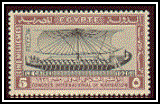 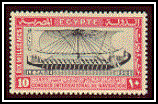 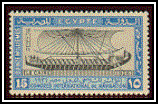
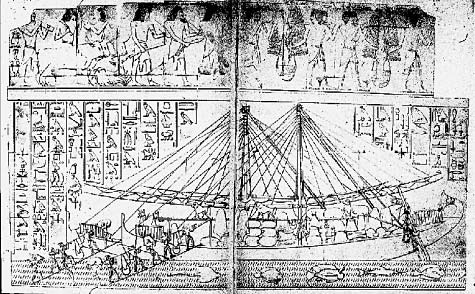
Departure From Punt
The best recorded examples of Egyptian seagoing
ships at the height of their development are those built for Queen
Hatshepsut's expedition to the land of Punt, which are depicted
in considerable detail on relief sculptures at her temple at Deir
el- Bahri. These ships from the mid 2nd millennium have much cleaner
lines than earlier iconography of ships. These ships are clearly
the product of nearly a millennium of refinement in shipbuilding
techniques. Nevertheless the fundamental design weaknesses persist
including the prominent hogging trusses and the 16 protruding deck
beams necessary to pin the sides of a weakly framed shell built
hull.
There is no evidence apparent in the relief sculpture
to show how the shell is constructed, but it must be assumed to
embody the dowelling and dovetailing techniques found in the Dashur
boats and later described by Herodotus. The stem posts of these
boats are straight, but the stern curves round and is decorated
with a lotus blossom, which is a common motif on Egyptian ships.
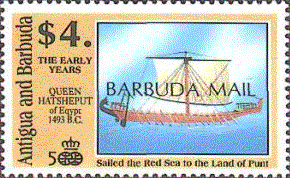 Ships
on Stamps (Hatshepsut's Ship) There are two large steering oars,
one on each side at the stern, which are turned by tillers, which
project downwards from the loom of the steering oar. The sail is
much wider than on earlier ships but the foot is still supported
by a boom and on one of the ships the yard has been lowered to the
boom rather than the foot raised to the yard, which would be the
normal way of furling a square sail. The yards are made of two long
spars fished together with a pronounced curvature and two vangs
or braces running to the ends of the yard rather than sheets attached
to the lower corners of the sail manipulate the sail. This method
of sail control is found in other ancient Mediterranean ships, including
those with loose-footed sails whereas in Northern Europe the practice
was to control the sail from the foot rather than the yard. The
mast is stepped roughly amidships and the standing rigging consists
of fore and backstays but no shrouds. In addition to the sailing
capability Hatshepsut's ships also have fifteen oarsmen on each
side. Allowing for an inters calm distance between the oarsmen of
just under three feet the central section of the ships must have
been around forty-five to fifty feet in length, and the overall
length may be estimated at around sixty to seventy feet. Ships
on Stamps (Hatshepsut's Ship) There are two large steering oars,
one on each side at the stern, which are turned by tillers, which
project downwards from the loom of the steering oar. The sail is
much wider than on earlier ships but the foot is still supported
by a boom and on one of the ships the yard has been lowered to the
boom rather than the foot raised to the yard, which would be the
normal way of furling a square sail. The yards are made of two long
spars fished together with a pronounced curvature and two vangs
or braces running to the ends of the yard rather than sheets attached
to the lower corners of the sail manipulate the sail. This method
of sail control is found in other ancient Mediterranean ships, including
those with loose-footed sails whereas in Northern Europe the practice
was to control the sail from the foot rather than the yard. The
mast is stepped roughly amidships and the standing rigging consists
of fore and backstays but no shrouds. In addition to the sailing
capability Hatshepsut's ships also have fifteen oarsmen on each
side. Allowing for an inters calm distance between the oarsmen of
just under three feet the central section of the ships must have
been around forty-five to fifty feet in length, and the overall
length may be estimated at around sixty to seventy feet.
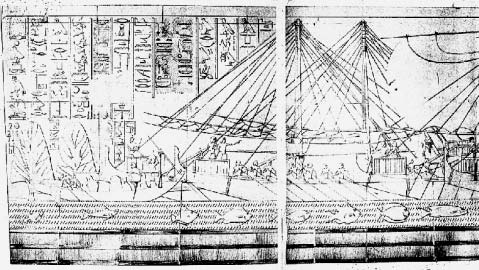
Copy from a relief recording Queen Hatshepsut's expedition to the
Land of Punt.
The interpretation of the conformation of Hatshepsut's ships from
antique wall sculpture raises many problems. For example the sails
are shown in a fore and aft position and though it may be assumed
that such ships could go on a beam reach this would probably not
be the normal sailing position. Also the artist has raised the waterline
on the boats by about one foot. The cargo in these illustrations
is shown stacked on the decks. This artistic license has been interpreted
by some researchers as implying these ships were not watertight
and, by extension, were really developed rafts rather than displacement
craft. This seems unlikely, primarily because the general design
and fittings of the ships are too sophisticated for a raft base,
and secondly because artistic conventions in this and other pictures,
requires that the cargo be displayed to the observer of the relief,
cargo stored in a conventional hold would be concealed from the
observer. Lastly it is impossible to make a determination of how
the ships were built and how the planking was fastened from these,
or from other roughly contemporary illustrations. The question of
the method of construction is crucial to a proper understanding
of the nature of these ships. The conditions met during journeys
at sea would impose stresses on the hulls, which would not be encountered
in a river environment.
We can reasonably conclude that the Egyptians had
extensive experience with displacement craft from at least the time
of building the Pyramids and that Hapshepsut would have had the
benefit of earlier experiences with the sea worthiness of ships
to draw upon for the design of her craft. This fundemental record
from Egyptian History of the ships of Queen Hatshepsut as recorded
in her temple mark an apex in our knowledge of Egyptian shipbuilding
in its unique form.
The accomplishments of Hatshepsut during her tenure
as ruler in Egypt is one of the unique chapter in Egyptian
History. Her legacy is even more monumental in light of the male
dominated linage of Egyptian rulers.
Previous |
Next | Table
Of Contents

|
